HI6008: Marketing Strategies and Consumer Behaviour Research Report
VerifiedAdded on 2022/11/09
|10
|3118
|1
Report
AI Summary
This business research project investigates the combined effect of social media and traditional marketing on consumer buying behaviour, focusing on the retail industry and using Coles as a case study. The report examines the research problem within the competitive Australian market, the role of brand loyalty, and the need to balance digital and traditional strategies. The research employs a mixed-method approach, utilizing both quantitative surveys and qualitative interviews, to analyze the impact of marketing strategies on consumer purchase decisions. The methodology includes a detailed explanation of the research philosophy (pragmatism), approach (deductive), and design (explanatory and sequential). The study aims to answer research questions regarding how companies achieve synergy between marketing forms and their impact on buying behavior, with brand loyalty as a mediating variable. Data collection methods, analysis techniques (content analysis, open, axial and selective coding), and sampling strategies are thoroughly described, providing a comprehensive overview of the research process.
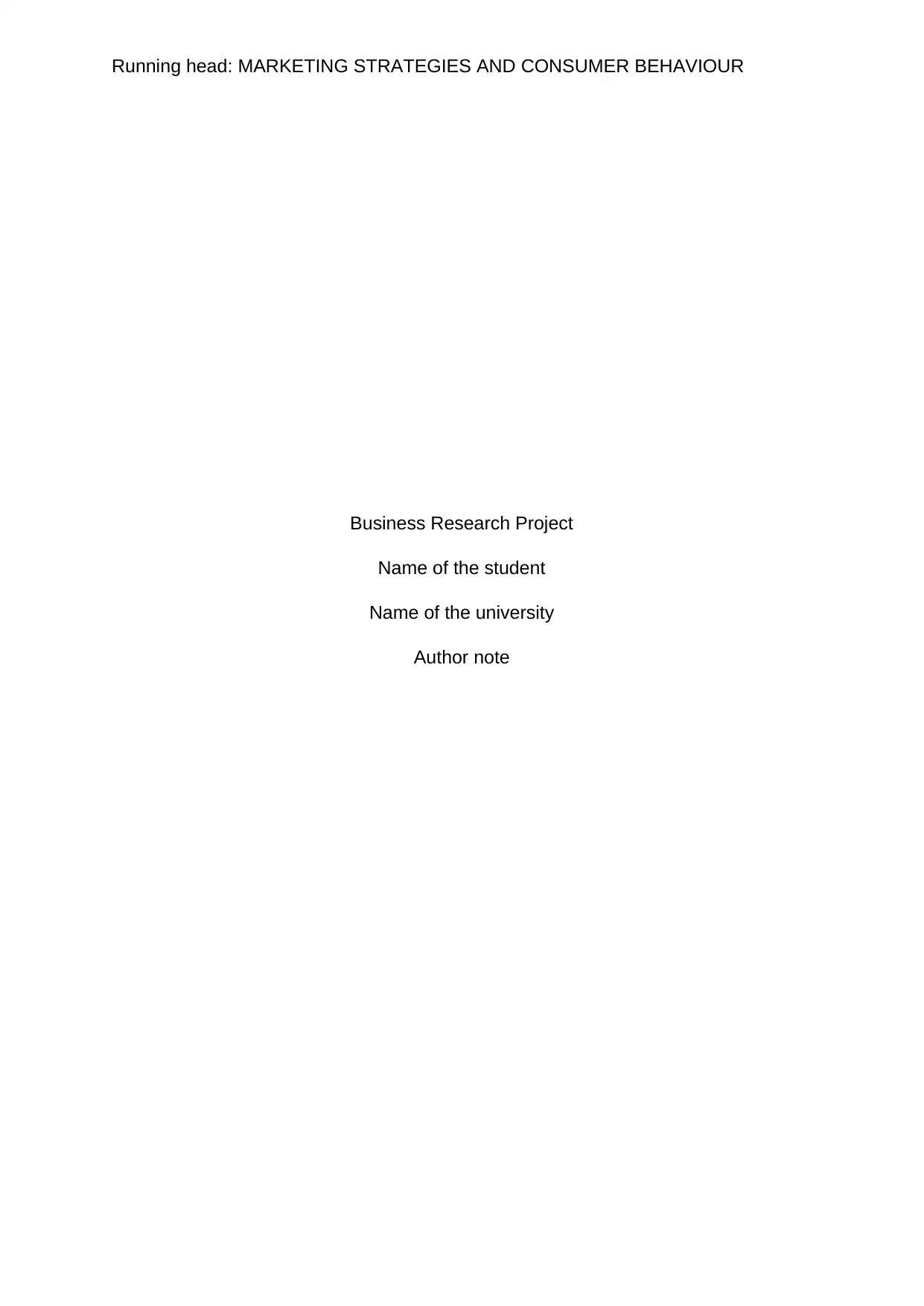
Running head: MARKETING STRATEGIES AND CONSUMER BEHAVIOUR
Business Research Project
Name of the student
Name of the university
Author note
Business Research Project
Name of the student
Name of the university
Author note
Paraphrase This Document
Need a fresh take? Get an instant paraphrase of this document with our AI Paraphraser
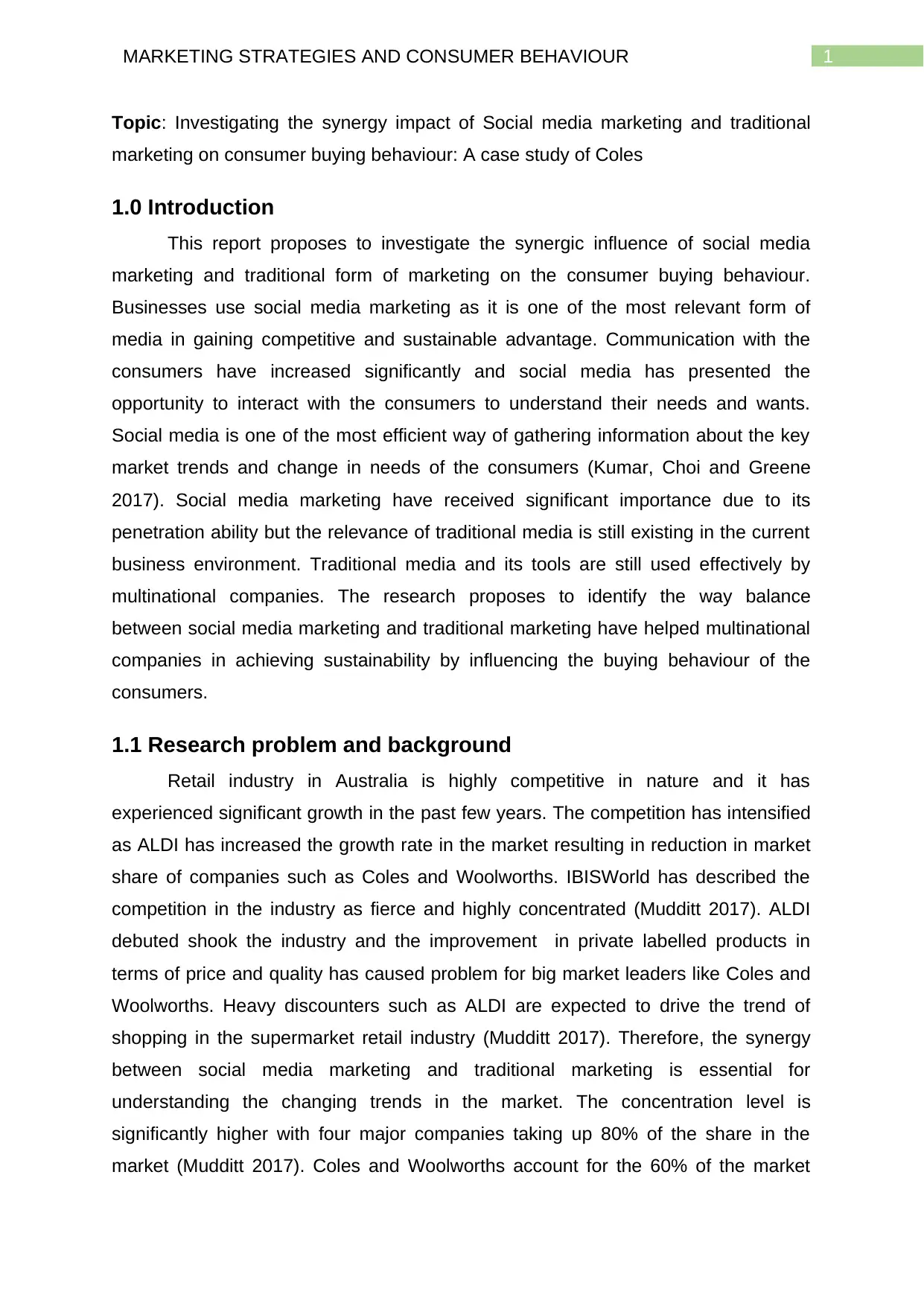
1MARKETING STRATEGIES AND CONSUMER BEHAVIOUR
Topic: Investigating the synergy impact of Social media marketing and traditional
marketing on consumer buying behaviour: A case study of Coles
1.0 Introduction
This report proposes to investigate the synergic influence of social media
marketing and traditional form of marketing on the consumer buying behaviour.
Businesses use social media marketing as it is one of the most relevant form of
media in gaining competitive and sustainable advantage. Communication with the
consumers have increased significantly and social media has presented the
opportunity to interact with the consumers to understand their needs and wants.
Social media is one of the most efficient way of gathering information about the key
market trends and change in needs of the consumers (Kumar, Choi and Greene
2017). Social media marketing have received significant importance due to its
penetration ability but the relevance of traditional media is still existing in the current
business environment. Traditional media and its tools are still used effectively by
multinational companies. The research proposes to identify the way balance
between social media marketing and traditional marketing have helped multinational
companies in achieving sustainability by influencing the buying behaviour of the
consumers.
1.1 Research problem and background
Retail industry in Australia is highly competitive in nature and it has
experienced significant growth in the past few years. The competition has intensified
as ALDI has increased the growth rate in the market resulting in reduction in market
share of companies such as Coles and Woolworths. IBISWorld has described the
competition in the industry as fierce and highly concentrated (Mudditt 2017). ALDI
debuted shook the industry and the improvement in private labelled products in
terms of price and quality has caused problem for big market leaders like Coles and
Woolworths. Heavy discounters such as ALDI are expected to drive the trend of
shopping in the supermarket retail industry (Mudditt 2017). Therefore, the synergy
between social media marketing and traditional marketing is essential for
understanding the changing trends in the market. The concentration level is
significantly higher with four major companies taking up 80% of the share in the
market (Mudditt 2017). Coles and Woolworths account for the 60% of the market
Topic: Investigating the synergy impact of Social media marketing and traditional
marketing on consumer buying behaviour: A case study of Coles
1.0 Introduction
This report proposes to investigate the synergic influence of social media
marketing and traditional form of marketing on the consumer buying behaviour.
Businesses use social media marketing as it is one of the most relevant form of
media in gaining competitive and sustainable advantage. Communication with the
consumers have increased significantly and social media has presented the
opportunity to interact with the consumers to understand their needs and wants.
Social media is one of the most efficient way of gathering information about the key
market trends and change in needs of the consumers (Kumar, Choi and Greene
2017). Social media marketing have received significant importance due to its
penetration ability but the relevance of traditional media is still existing in the current
business environment. Traditional media and its tools are still used effectively by
multinational companies. The research proposes to identify the way balance
between social media marketing and traditional marketing have helped multinational
companies in achieving sustainability by influencing the buying behaviour of the
consumers.
1.1 Research problem and background
Retail industry in Australia is highly competitive in nature and it has
experienced significant growth in the past few years. The competition has intensified
as ALDI has increased the growth rate in the market resulting in reduction in market
share of companies such as Coles and Woolworths. IBISWorld has described the
competition in the industry as fierce and highly concentrated (Mudditt 2017). ALDI
debuted shook the industry and the improvement in private labelled products in
terms of price and quality has caused problem for big market leaders like Coles and
Woolworths. Heavy discounters such as ALDI are expected to drive the trend of
shopping in the supermarket retail industry (Mudditt 2017). Therefore, the synergy
between social media marketing and traditional marketing is essential for
understanding the changing trends in the market. The concentration level is
significantly higher with four major companies taking up 80% of the share in the
market (Mudditt 2017). Coles and Woolworths account for the 60% of the market
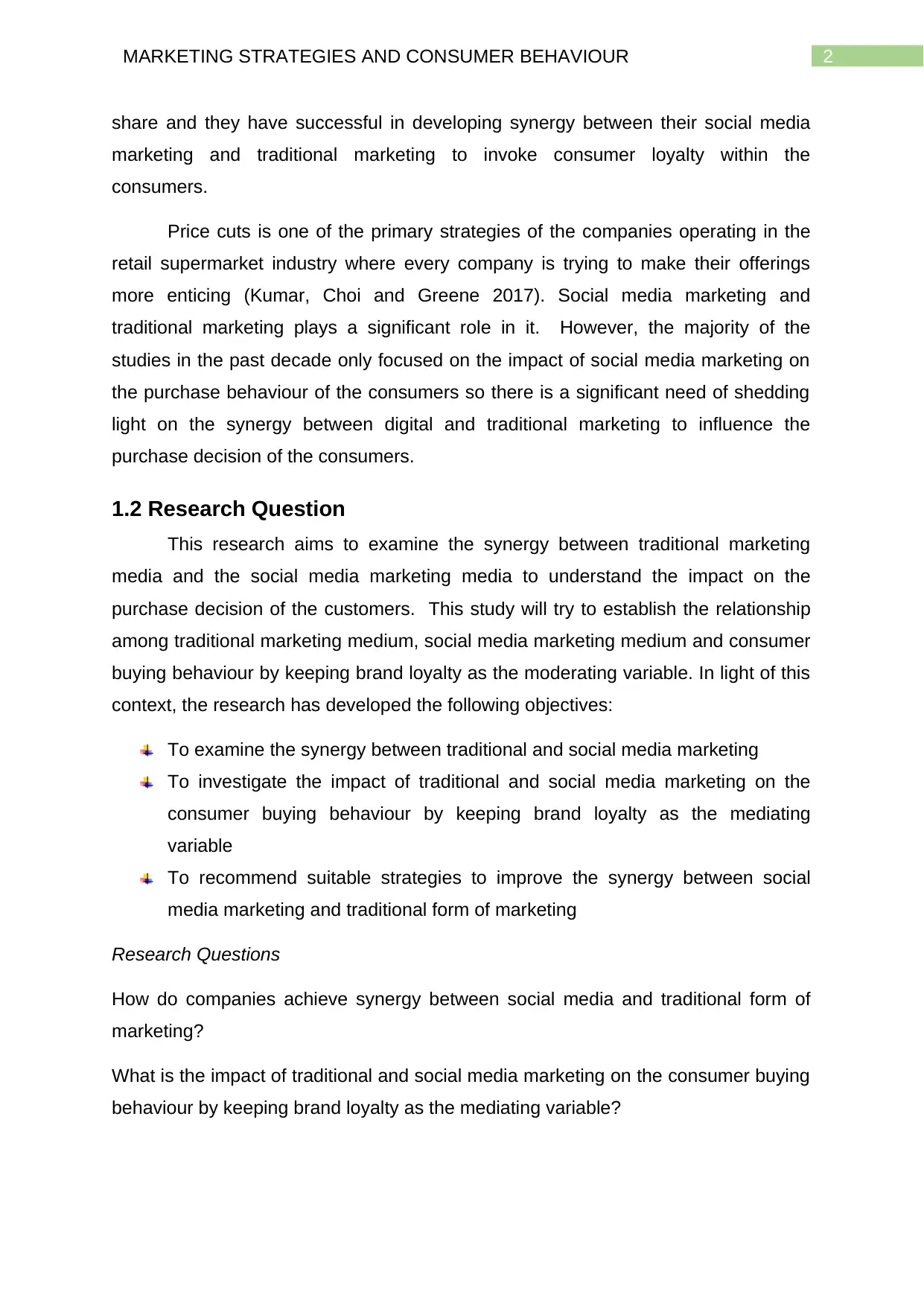
2MARKETING STRATEGIES AND CONSUMER BEHAVIOUR
share and they have successful in developing synergy between their social media
marketing and traditional marketing to invoke consumer loyalty within the
consumers.
Price cuts is one of the primary strategies of the companies operating in the
retail supermarket industry where every company is trying to make their offerings
more enticing (Kumar, Choi and Greene 2017). Social media marketing and
traditional marketing plays a significant role in it. However, the majority of the
studies in the past decade only focused on the impact of social media marketing on
the purchase behaviour of the consumers so there is a significant need of shedding
light on the synergy between digital and traditional marketing to influence the
purchase decision of the consumers.
1.2 Research Question
This research aims to examine the synergy between traditional marketing
media and the social media marketing media to understand the impact on the
purchase decision of the customers. This study will try to establish the relationship
among traditional marketing medium, social media marketing medium and consumer
buying behaviour by keeping brand loyalty as the moderating variable. In light of this
context, the research has developed the following objectives:
To examine the synergy between traditional and social media marketing
To investigate the impact of traditional and social media marketing on the
consumer buying behaviour by keeping brand loyalty as the mediating
variable
To recommend suitable strategies to improve the synergy between social
media marketing and traditional form of marketing
Research Questions
How do companies achieve synergy between social media and traditional form of
marketing?
What is the impact of traditional and social media marketing on the consumer buying
behaviour by keeping brand loyalty as the mediating variable?
share and they have successful in developing synergy between their social media
marketing and traditional marketing to invoke consumer loyalty within the
consumers.
Price cuts is one of the primary strategies of the companies operating in the
retail supermarket industry where every company is trying to make their offerings
more enticing (Kumar, Choi and Greene 2017). Social media marketing and
traditional marketing plays a significant role in it. However, the majority of the
studies in the past decade only focused on the impact of social media marketing on
the purchase behaviour of the consumers so there is a significant need of shedding
light on the synergy between digital and traditional marketing to influence the
purchase decision of the consumers.
1.2 Research Question
This research aims to examine the synergy between traditional marketing
media and the social media marketing media to understand the impact on the
purchase decision of the customers. This study will try to establish the relationship
among traditional marketing medium, social media marketing medium and consumer
buying behaviour by keeping brand loyalty as the moderating variable. In light of this
context, the research has developed the following objectives:
To examine the synergy between traditional and social media marketing
To investigate the impact of traditional and social media marketing on the
consumer buying behaviour by keeping brand loyalty as the mediating
variable
To recommend suitable strategies to improve the synergy between social
media marketing and traditional form of marketing
Research Questions
How do companies achieve synergy between social media and traditional form of
marketing?
What is the impact of traditional and social media marketing on the consumer buying
behaviour by keeping brand loyalty as the mediating variable?
⊘ This is a preview!⊘
Do you want full access?
Subscribe today to unlock all pages.

Trusted by 1+ million students worldwide
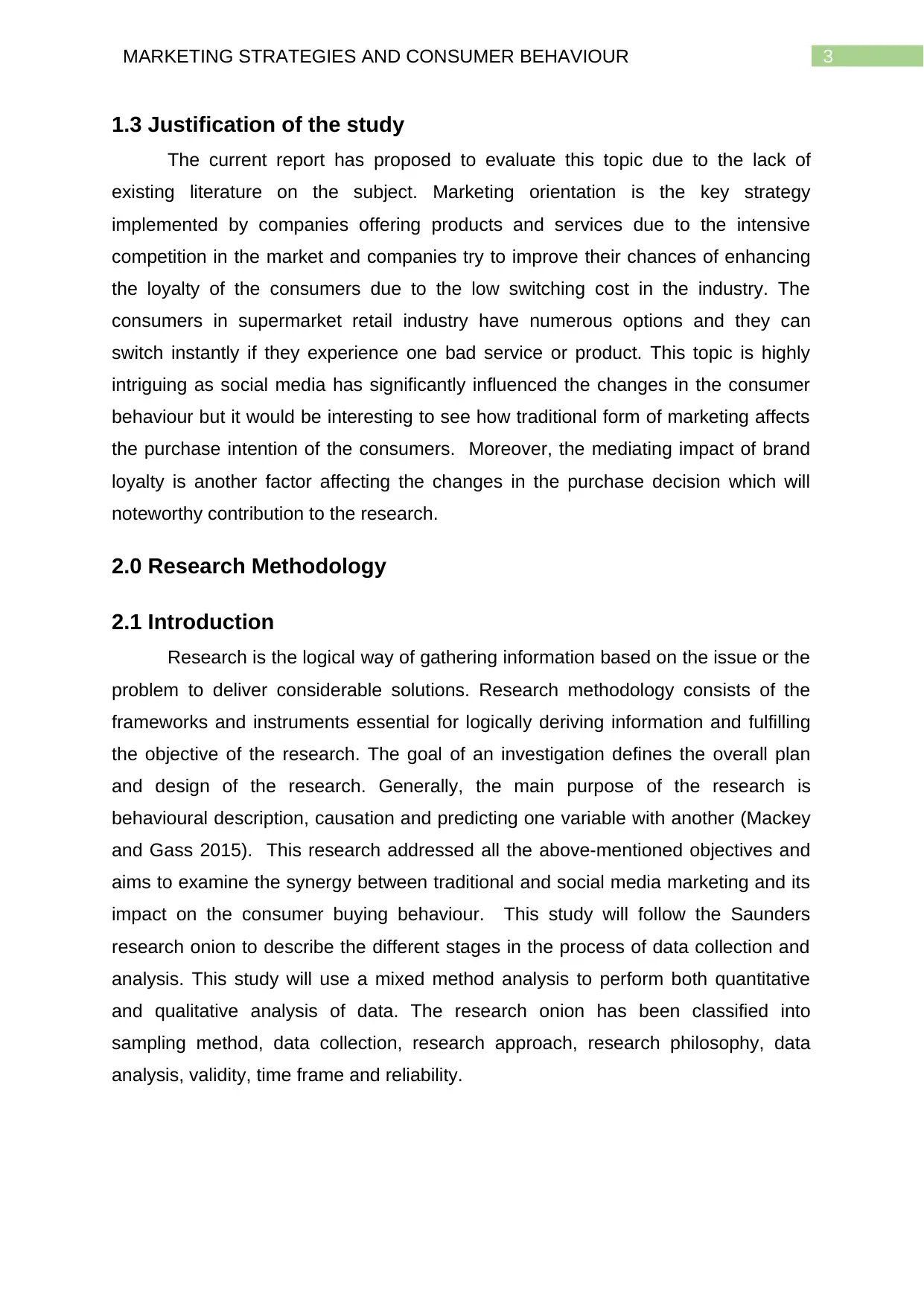
3MARKETING STRATEGIES AND CONSUMER BEHAVIOUR
1.3 Justification of the study
The current report has proposed to evaluate this topic due to the lack of
existing literature on the subject. Marketing orientation is the key strategy
implemented by companies offering products and services due to the intensive
competition in the market and companies try to improve their chances of enhancing
the loyalty of the consumers due to the low switching cost in the industry. The
consumers in supermarket retail industry have numerous options and they can
switch instantly if they experience one bad service or product. This topic is highly
intriguing as social media has significantly influenced the changes in the consumer
behaviour but it would be interesting to see how traditional form of marketing affects
the purchase intention of the consumers. Moreover, the mediating impact of brand
loyalty is another factor affecting the changes in the purchase decision which will
noteworthy contribution to the research.
2.0 Research Methodology
2.1 Introduction
Research is the logical way of gathering information based on the issue or the
problem to deliver considerable solutions. Research methodology consists of the
frameworks and instruments essential for logically deriving information and fulfilling
the objective of the research. The goal of an investigation defines the overall plan
and design of the research. Generally, the main purpose of the research is
behavioural description, causation and predicting one variable with another (Mackey
and Gass 2015). This research addressed all the above-mentioned objectives and
aims to examine the synergy between traditional and social media marketing and its
impact on the consumer buying behaviour. This study will follow the Saunders
research onion to describe the different stages in the process of data collection and
analysis. This study will use a mixed method analysis to perform both quantitative
and qualitative analysis of data. The research onion has been classified into
sampling method, data collection, research approach, research philosophy, data
analysis, validity, time frame and reliability.
1.3 Justification of the study
The current report has proposed to evaluate this topic due to the lack of
existing literature on the subject. Marketing orientation is the key strategy
implemented by companies offering products and services due to the intensive
competition in the market and companies try to improve their chances of enhancing
the loyalty of the consumers due to the low switching cost in the industry. The
consumers in supermarket retail industry have numerous options and they can
switch instantly if they experience one bad service or product. This topic is highly
intriguing as social media has significantly influenced the changes in the consumer
behaviour but it would be interesting to see how traditional form of marketing affects
the purchase intention of the consumers. Moreover, the mediating impact of brand
loyalty is another factor affecting the changes in the purchase decision which will
noteworthy contribution to the research.
2.0 Research Methodology
2.1 Introduction
Research is the logical way of gathering information based on the issue or the
problem to deliver considerable solutions. Research methodology consists of the
frameworks and instruments essential for logically deriving information and fulfilling
the objective of the research. The goal of an investigation defines the overall plan
and design of the research. Generally, the main purpose of the research is
behavioural description, causation and predicting one variable with another (Mackey
and Gass 2015). This research addressed all the above-mentioned objectives and
aims to examine the synergy between traditional and social media marketing and its
impact on the consumer buying behaviour. This study will follow the Saunders
research onion to describe the different stages in the process of data collection and
analysis. This study will use a mixed method analysis to perform both quantitative
and qualitative analysis of data. The research onion has been classified into
sampling method, data collection, research approach, research philosophy, data
analysis, validity, time frame and reliability.
Paraphrase This Document
Need a fresh take? Get an instant paraphrase of this document with our AI Paraphraser
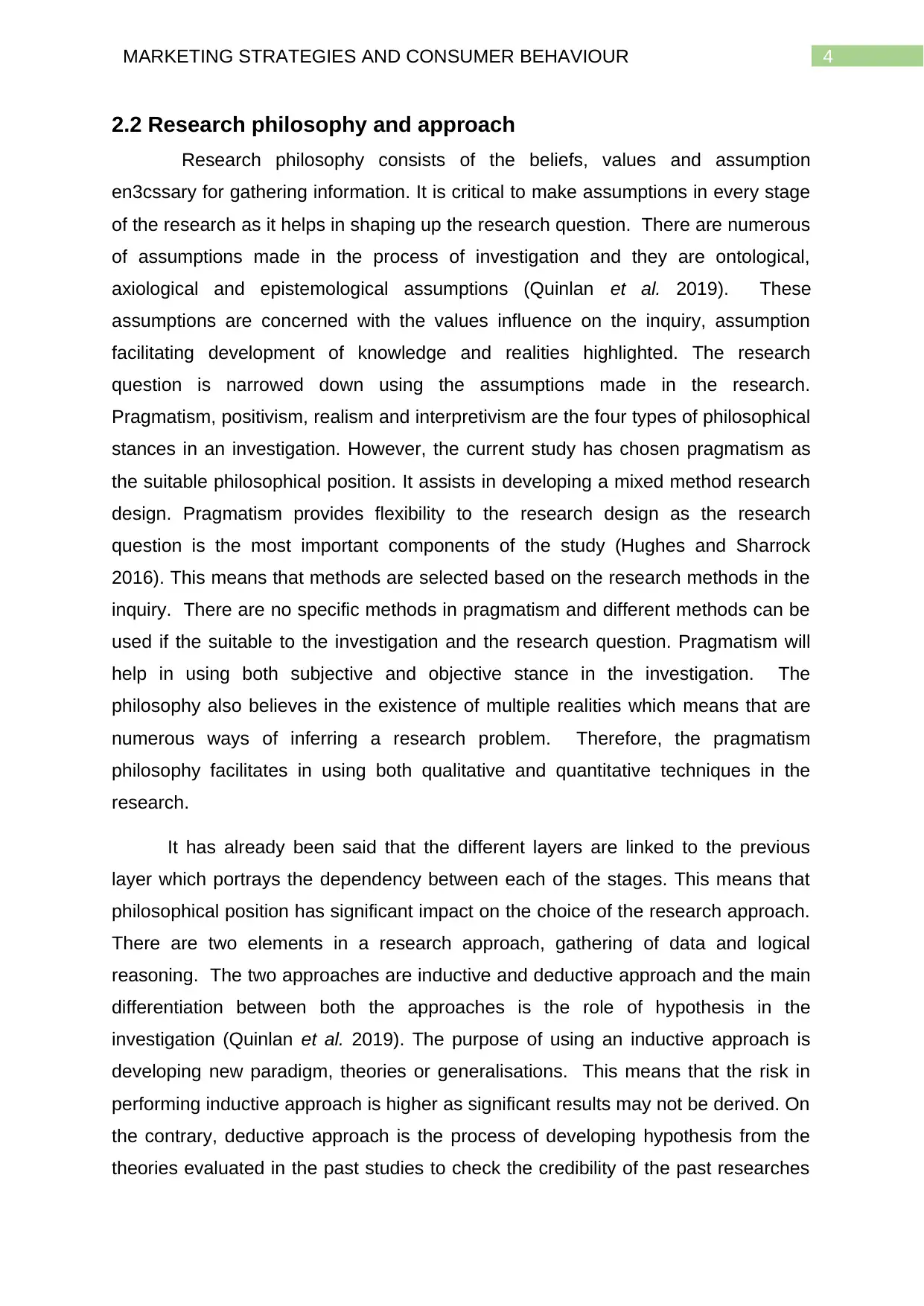
4MARKETING STRATEGIES AND CONSUMER BEHAVIOUR
2.2 Research philosophy and approach
Research philosophy consists of the beliefs, values and assumption
en3cssary for gathering information. It is critical to make assumptions in every stage
of the research as it helps in shaping up the research question. There are numerous
of assumptions made in the process of investigation and they are ontological,
axiological and epistemological assumptions (Quinlan et al. 2019). These
assumptions are concerned with the values influence on the inquiry, assumption
facilitating development of knowledge and realities highlighted. The research
question is narrowed down using the assumptions made in the research.
Pragmatism, positivism, realism and interpretivism are the four types of philosophical
stances in an investigation. However, the current study has chosen pragmatism as
the suitable philosophical position. It assists in developing a mixed method research
design. Pragmatism provides flexibility to the research design as the research
question is the most important components of the study (Hughes and Sharrock
2016). This means that methods are selected based on the research methods in the
inquiry. There are no specific methods in pragmatism and different methods can be
used if the suitable to the investigation and the research question. Pragmatism will
help in using both subjective and objective stance in the investigation. The
philosophy also believes in the existence of multiple realities which means that are
numerous ways of inferring a research problem. Therefore, the pragmatism
philosophy facilitates in using both qualitative and quantitative techniques in the
research.
It has already been said that the different layers are linked to the previous
layer which portrays the dependency between each of the stages. This means that
philosophical position has significant impact on the choice of the research approach.
There are two elements in a research approach, gathering of data and logical
reasoning. The two approaches are inductive and deductive approach and the main
differentiation between both the approaches is the role of hypothesis in the
investigation (Quinlan et al. 2019). The purpose of using an inductive approach is
developing new paradigm, theories or generalisations. This means that the risk in
performing inductive approach is higher as significant results may not be derived. On
the contrary, deductive approach is the process of developing hypothesis from the
theories evaluated in the past studies to check the credibility of the past researches
2.2 Research philosophy and approach
Research philosophy consists of the beliefs, values and assumption
en3cssary for gathering information. It is critical to make assumptions in every stage
of the research as it helps in shaping up the research question. There are numerous
of assumptions made in the process of investigation and they are ontological,
axiological and epistemological assumptions (Quinlan et al. 2019). These
assumptions are concerned with the values influence on the inquiry, assumption
facilitating development of knowledge and realities highlighted. The research
question is narrowed down using the assumptions made in the research.
Pragmatism, positivism, realism and interpretivism are the four types of philosophical
stances in an investigation. However, the current study has chosen pragmatism as
the suitable philosophical position. It assists in developing a mixed method research
design. Pragmatism provides flexibility to the research design as the research
question is the most important components of the study (Hughes and Sharrock
2016). This means that methods are selected based on the research methods in the
inquiry. There are no specific methods in pragmatism and different methods can be
used if the suitable to the investigation and the research question. Pragmatism will
help in using both subjective and objective stance in the investigation. The
philosophy also believes in the existence of multiple realities which means that are
numerous ways of inferring a research problem. Therefore, the pragmatism
philosophy facilitates in using both qualitative and quantitative techniques in the
research.
It has already been said that the different layers are linked to the previous
layer which portrays the dependency between each of the stages. This means that
philosophical position has significant impact on the choice of the research approach.
There are two elements in a research approach, gathering of data and logical
reasoning. The two approaches are inductive and deductive approach and the main
differentiation between both the approaches is the role of hypothesis in the
investigation (Quinlan et al. 2019). The purpose of using an inductive approach is
developing new paradigm, theories or generalisations. This means that the risk in
performing inductive approach is higher as significant results may not be derived. On
the contrary, deductive approach is the process of developing hypothesis from the
theories evaluated in the past studies to check the credibility of the past researches
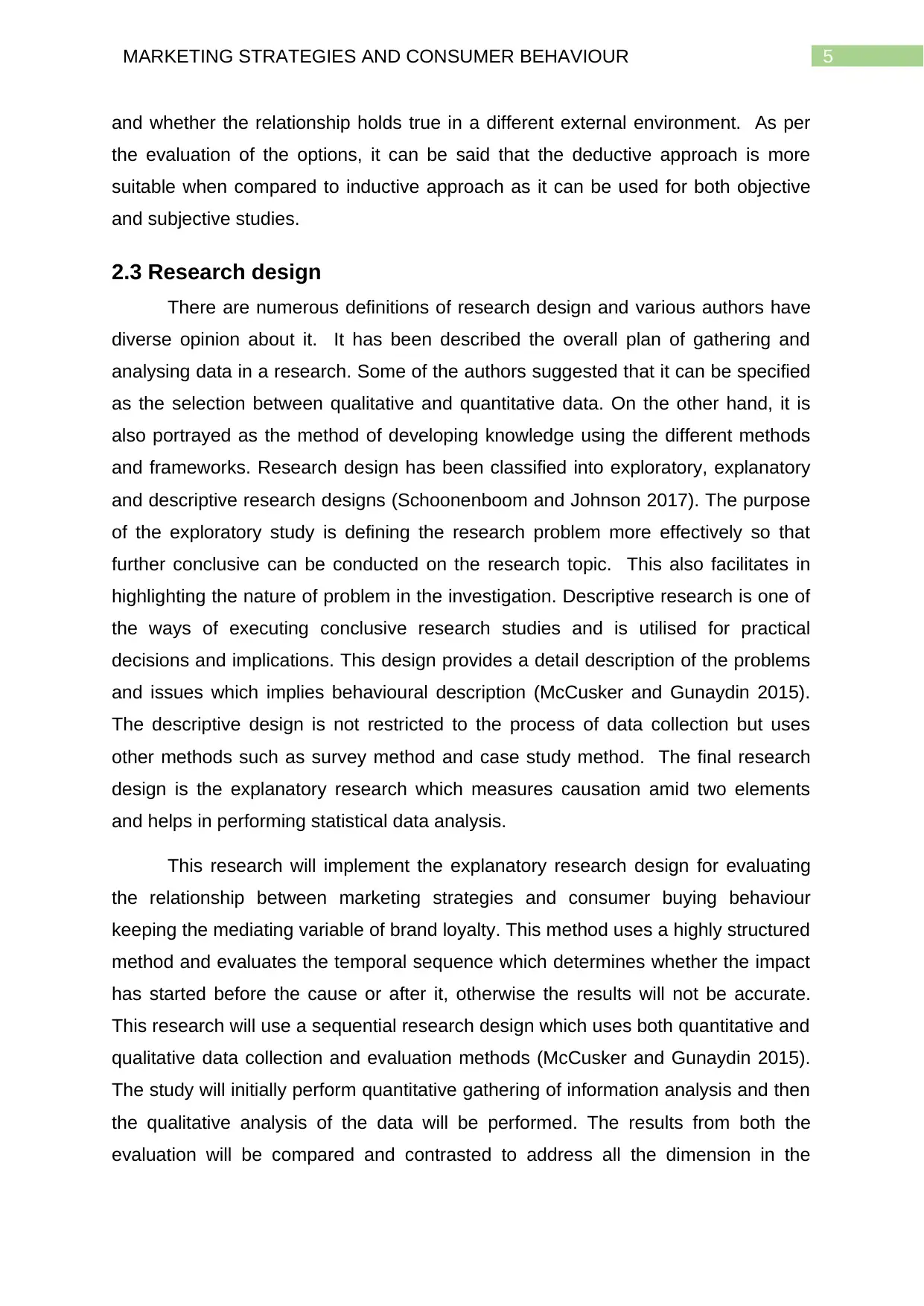
5MARKETING STRATEGIES AND CONSUMER BEHAVIOUR
and whether the relationship holds true in a different external environment. As per
the evaluation of the options, it can be said that the deductive approach is more
suitable when compared to inductive approach as it can be used for both objective
and subjective studies.
2.3 Research design
There are numerous definitions of research design and various authors have
diverse opinion about it. It has been described the overall plan of gathering and
analysing data in a research. Some of the authors suggested that it can be specified
as the selection between qualitative and quantitative data. On the other hand, it is
also portrayed as the method of developing knowledge using the different methods
and frameworks. Research design has been classified into exploratory, explanatory
and descriptive research designs (Schoonenboom and Johnson 2017). The purpose
of the exploratory study is defining the research problem more effectively so that
further conclusive can be conducted on the research topic. This also facilitates in
highlighting the nature of problem in the investigation. Descriptive research is one of
the ways of executing conclusive research studies and is utilised for practical
decisions and implications. This design provides a detail description of the problems
and issues which implies behavioural description (McCusker and Gunaydin 2015).
The descriptive design is not restricted to the process of data collection but uses
other methods such as survey method and case study method. The final research
design is the explanatory research which measures causation amid two elements
and helps in performing statistical data analysis.
This research will implement the explanatory research design for evaluating
the relationship between marketing strategies and consumer buying behaviour
keeping the mediating variable of brand loyalty. This method uses a highly structured
method and evaluates the temporal sequence which determines whether the impact
has started before the cause or after it, otherwise the results will not be accurate.
This research will use a sequential research design which uses both quantitative and
qualitative data collection and evaluation methods (McCusker and Gunaydin 2015).
The study will initially perform quantitative gathering of information analysis and then
the qualitative analysis of the data will be performed. The results from both the
evaluation will be compared and contrasted to address all the dimension in the
and whether the relationship holds true in a different external environment. As per
the evaluation of the options, it can be said that the deductive approach is more
suitable when compared to inductive approach as it can be used for both objective
and subjective studies.
2.3 Research design
There are numerous definitions of research design and various authors have
diverse opinion about it. It has been described the overall plan of gathering and
analysing data in a research. Some of the authors suggested that it can be specified
as the selection between qualitative and quantitative data. On the other hand, it is
also portrayed as the method of developing knowledge using the different methods
and frameworks. Research design has been classified into exploratory, explanatory
and descriptive research designs (Schoonenboom and Johnson 2017). The purpose
of the exploratory study is defining the research problem more effectively so that
further conclusive can be conducted on the research topic. This also facilitates in
highlighting the nature of problem in the investigation. Descriptive research is one of
the ways of executing conclusive research studies and is utilised for practical
decisions and implications. This design provides a detail description of the problems
and issues which implies behavioural description (McCusker and Gunaydin 2015).
The descriptive design is not restricted to the process of data collection but uses
other methods such as survey method and case study method. The final research
design is the explanatory research which measures causation amid two elements
and helps in performing statistical data analysis.
This research will implement the explanatory research design for evaluating
the relationship between marketing strategies and consumer buying behaviour
keeping the mediating variable of brand loyalty. This method uses a highly structured
method and evaluates the temporal sequence which determines whether the impact
has started before the cause or after it, otherwise the results will not be accurate.
This research will use a sequential research design which uses both quantitative and
qualitative data collection and evaluation methods (McCusker and Gunaydin 2015).
The study will initially perform quantitative gathering of information analysis and then
the qualitative analysis of the data will be performed. The results from both the
evaluation will be compared and contrasted to address all the dimension in the
⊘ This is a preview!⊘
Do you want full access?
Subscribe today to unlock all pages.

Trusted by 1+ million students worldwide
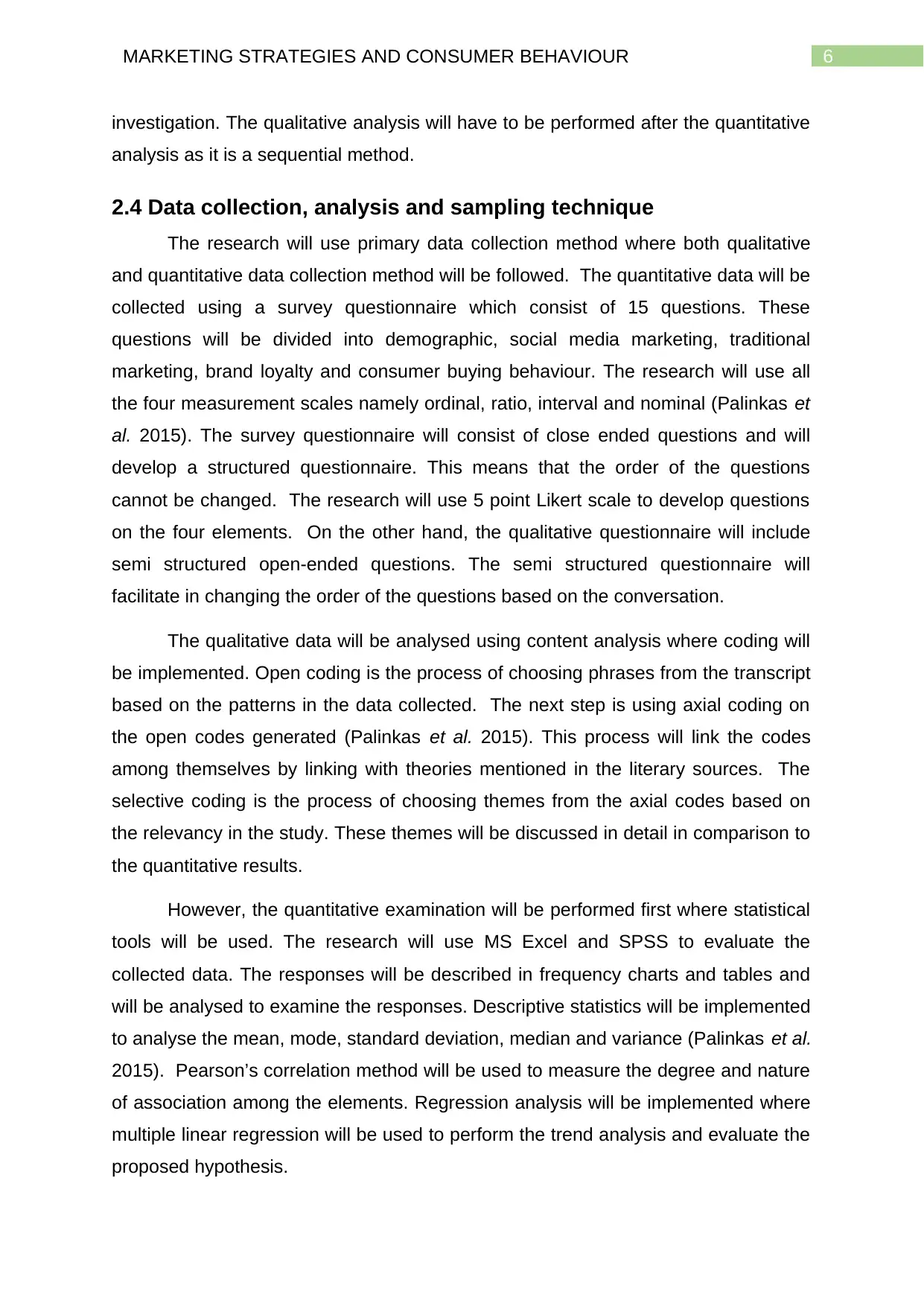
6MARKETING STRATEGIES AND CONSUMER BEHAVIOUR
investigation. The qualitative analysis will have to be performed after the quantitative
analysis as it is a sequential method.
2.4 Data collection, analysis and sampling technique
The research will use primary data collection method where both qualitative
and quantitative data collection method will be followed. The quantitative data will be
collected using a survey questionnaire which consist of 15 questions. These
questions will be divided into demographic, social media marketing, traditional
marketing, brand loyalty and consumer buying behaviour. The research will use all
the four measurement scales namely ordinal, ratio, interval and nominal (Palinkas et
al. 2015). The survey questionnaire will consist of close ended questions and will
develop a structured questionnaire. This means that the order of the questions
cannot be changed. The research will use 5 point Likert scale to develop questions
on the four elements. On the other hand, the qualitative questionnaire will include
semi structured open-ended questions. The semi structured questionnaire will
facilitate in changing the order of the questions based on the conversation.
The qualitative data will be analysed using content analysis where coding will
be implemented. Open coding is the process of choosing phrases from the transcript
based on the patterns in the data collected. The next step is using axial coding on
the open codes generated (Palinkas et al. 2015). This process will link the codes
among themselves by linking with theories mentioned in the literary sources. The
selective coding is the process of choosing themes from the axial codes based on
the relevancy in the study. These themes will be discussed in detail in comparison to
the quantitative results.
However, the quantitative examination will be performed first where statistical
tools will be used. The research will use MS Excel and SPSS to evaluate the
collected data. The responses will be described in frequency charts and tables and
will be analysed to examine the responses. Descriptive statistics will be implemented
to analyse the mean, mode, standard deviation, median and variance (Palinkas et al.
2015). Pearson’s correlation method will be used to measure the degree and nature
of association among the elements. Regression analysis will be implemented where
multiple linear regression will be used to perform the trend analysis and evaluate the
proposed hypothesis.
investigation. The qualitative analysis will have to be performed after the quantitative
analysis as it is a sequential method.
2.4 Data collection, analysis and sampling technique
The research will use primary data collection method where both qualitative
and quantitative data collection method will be followed. The quantitative data will be
collected using a survey questionnaire which consist of 15 questions. These
questions will be divided into demographic, social media marketing, traditional
marketing, brand loyalty and consumer buying behaviour. The research will use all
the four measurement scales namely ordinal, ratio, interval and nominal (Palinkas et
al. 2015). The survey questionnaire will consist of close ended questions and will
develop a structured questionnaire. This means that the order of the questions
cannot be changed. The research will use 5 point Likert scale to develop questions
on the four elements. On the other hand, the qualitative questionnaire will include
semi structured open-ended questions. The semi structured questionnaire will
facilitate in changing the order of the questions based on the conversation.
The qualitative data will be analysed using content analysis where coding will
be implemented. Open coding is the process of choosing phrases from the transcript
based on the patterns in the data collected. The next step is using axial coding on
the open codes generated (Palinkas et al. 2015). This process will link the codes
among themselves by linking with theories mentioned in the literary sources. The
selective coding is the process of choosing themes from the axial codes based on
the relevancy in the study. These themes will be discussed in detail in comparison to
the quantitative results.
However, the quantitative examination will be performed first where statistical
tools will be used. The research will use MS Excel and SPSS to evaluate the
collected data. The responses will be described in frequency charts and tables and
will be analysed to examine the responses. Descriptive statistics will be implemented
to analyse the mean, mode, standard deviation, median and variance (Palinkas et al.
2015). Pearson’s correlation method will be used to measure the degree and nature
of association among the elements. Regression analysis will be implemented where
multiple linear regression will be used to perform the trend analysis and evaluate the
proposed hypothesis.
Paraphrase This Document
Need a fresh take? Get an instant paraphrase of this document with our AI Paraphraser
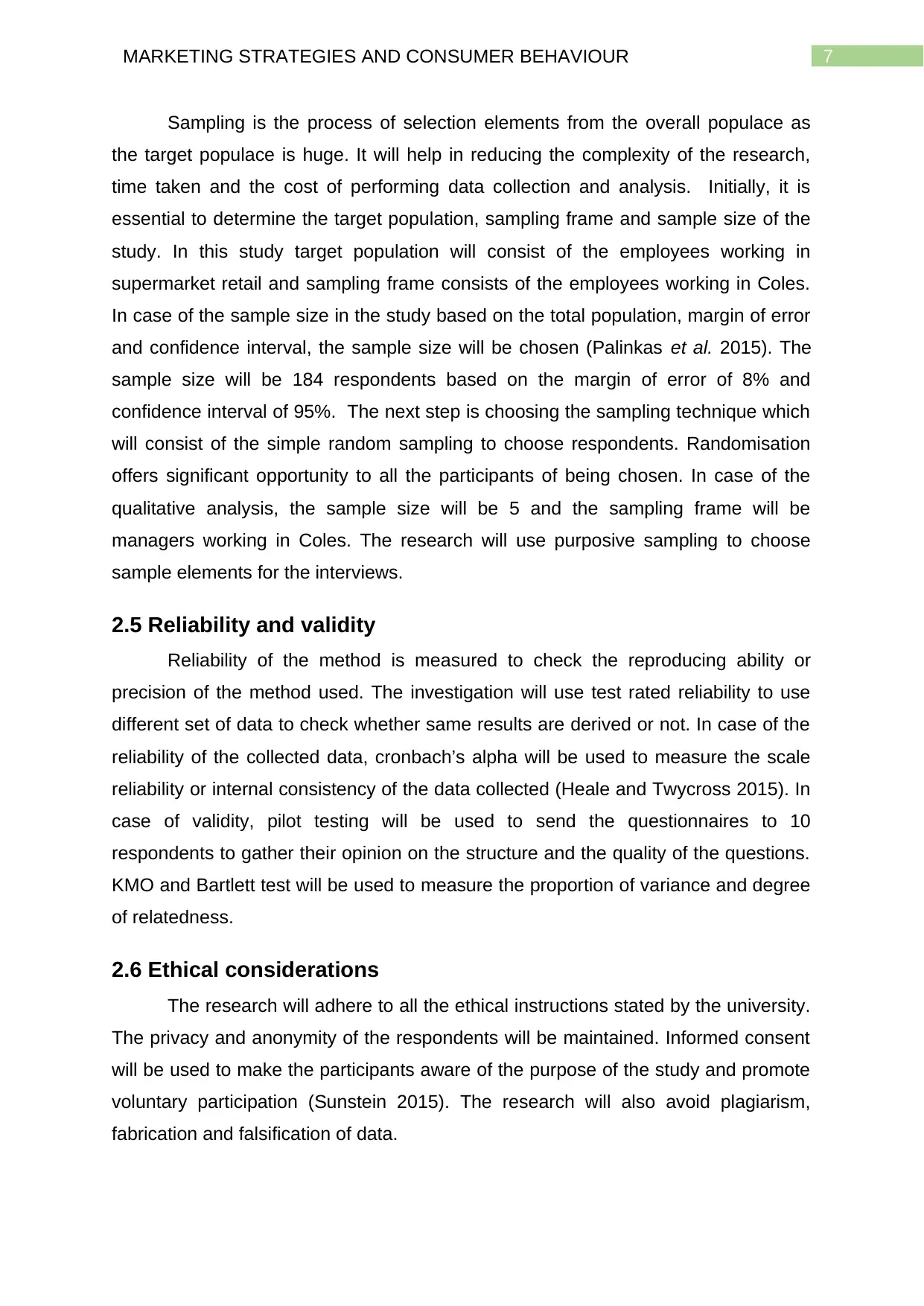
7MARKETING STRATEGIES AND CONSUMER BEHAVIOUR
Sampling is the process of selection elements from the overall populace as
the target populace is huge. It will help in reducing the complexity of the research,
time taken and the cost of performing data collection and analysis. Initially, it is
essential to determine the target population, sampling frame and sample size of the
study. In this study target population will consist of the employees working in
supermarket retail and sampling frame consists of the employees working in Coles.
In case of the sample size in the study based on the total population, margin of error
and confidence interval, the sample size will be chosen (Palinkas et al. 2015). The
sample size will be 184 respondents based on the margin of error of 8% and
confidence interval of 95%. The next step is choosing the sampling technique which
will consist of the simple random sampling to choose respondents. Randomisation
offers significant opportunity to all the participants of being chosen. In case of the
qualitative analysis, the sample size will be 5 and the sampling frame will be
managers working in Coles. The research will use purposive sampling to choose
sample elements for the interviews.
2.5 Reliability and validity
Reliability of the method is measured to check the reproducing ability or
precision of the method used. The investigation will use test rated reliability to use
different set of data to check whether same results are derived or not. In case of the
reliability of the collected data, cronbach’s alpha will be used to measure the scale
reliability or internal consistency of the data collected (Heale and Twycross 2015). In
case of validity, pilot testing will be used to send the questionnaires to 10
respondents to gather their opinion on the structure and the quality of the questions.
KMO and Bartlett test will be used to measure the proportion of variance and degree
of relatedness.
2.6 Ethical considerations
The research will adhere to all the ethical instructions stated by the university.
The privacy and anonymity of the respondents will be maintained. Informed consent
will be used to make the participants aware of the purpose of the study and promote
voluntary participation (Sunstein 2015). The research will also avoid plagiarism,
fabrication and falsification of data.
Sampling is the process of selection elements from the overall populace as
the target populace is huge. It will help in reducing the complexity of the research,
time taken and the cost of performing data collection and analysis. Initially, it is
essential to determine the target population, sampling frame and sample size of the
study. In this study target population will consist of the employees working in
supermarket retail and sampling frame consists of the employees working in Coles.
In case of the sample size in the study based on the total population, margin of error
and confidence interval, the sample size will be chosen (Palinkas et al. 2015). The
sample size will be 184 respondents based on the margin of error of 8% and
confidence interval of 95%. The next step is choosing the sampling technique which
will consist of the simple random sampling to choose respondents. Randomisation
offers significant opportunity to all the participants of being chosen. In case of the
qualitative analysis, the sample size will be 5 and the sampling frame will be
managers working in Coles. The research will use purposive sampling to choose
sample elements for the interviews.
2.5 Reliability and validity
Reliability of the method is measured to check the reproducing ability or
precision of the method used. The investigation will use test rated reliability to use
different set of data to check whether same results are derived or not. In case of the
reliability of the collected data, cronbach’s alpha will be used to measure the scale
reliability or internal consistency of the data collected (Heale and Twycross 2015). In
case of validity, pilot testing will be used to send the questionnaires to 10
respondents to gather their opinion on the structure and the quality of the questions.
KMO and Bartlett test will be used to measure the proportion of variance and degree
of relatedness.
2.6 Ethical considerations
The research will adhere to all the ethical instructions stated by the university.
The privacy and anonymity of the respondents will be maintained. Informed consent
will be used to make the participants aware of the purpose of the study and promote
voluntary participation (Sunstein 2015). The research will also avoid plagiarism,
fabrication and falsification of data.

8MARKETING STRATEGIES AND CONSUMER BEHAVIOUR
3.0 Expected outcome
The study is expected to derive significant relationship between marketing
strategies and consumer behaviour with respect to brand loyalty. Moreover, the
study will also be expected to identify synergy between social media marketing and
traditional form of marketing.
4.0 Conclusion
The research will develop relevant conclusion if all the proposed methods are
used or not. Thus, it can be concluded that all the proposed methods are ideal for
the research and should be used. However, changes can be made based on the
future circumstances depending upon the requirement.
3.0 Expected outcome
The study is expected to derive significant relationship between marketing
strategies and consumer behaviour with respect to brand loyalty. Moreover, the
study will also be expected to identify synergy between social media marketing and
traditional form of marketing.
4.0 Conclusion
The research will develop relevant conclusion if all the proposed methods are
used or not. Thus, it can be concluded that all the proposed methods are ideal for
the research and should be used. However, changes can be made based on the
future circumstances depending upon the requirement.
⊘ This is a preview!⊘
Do you want full access?
Subscribe today to unlock all pages.

Trusted by 1+ million students worldwide
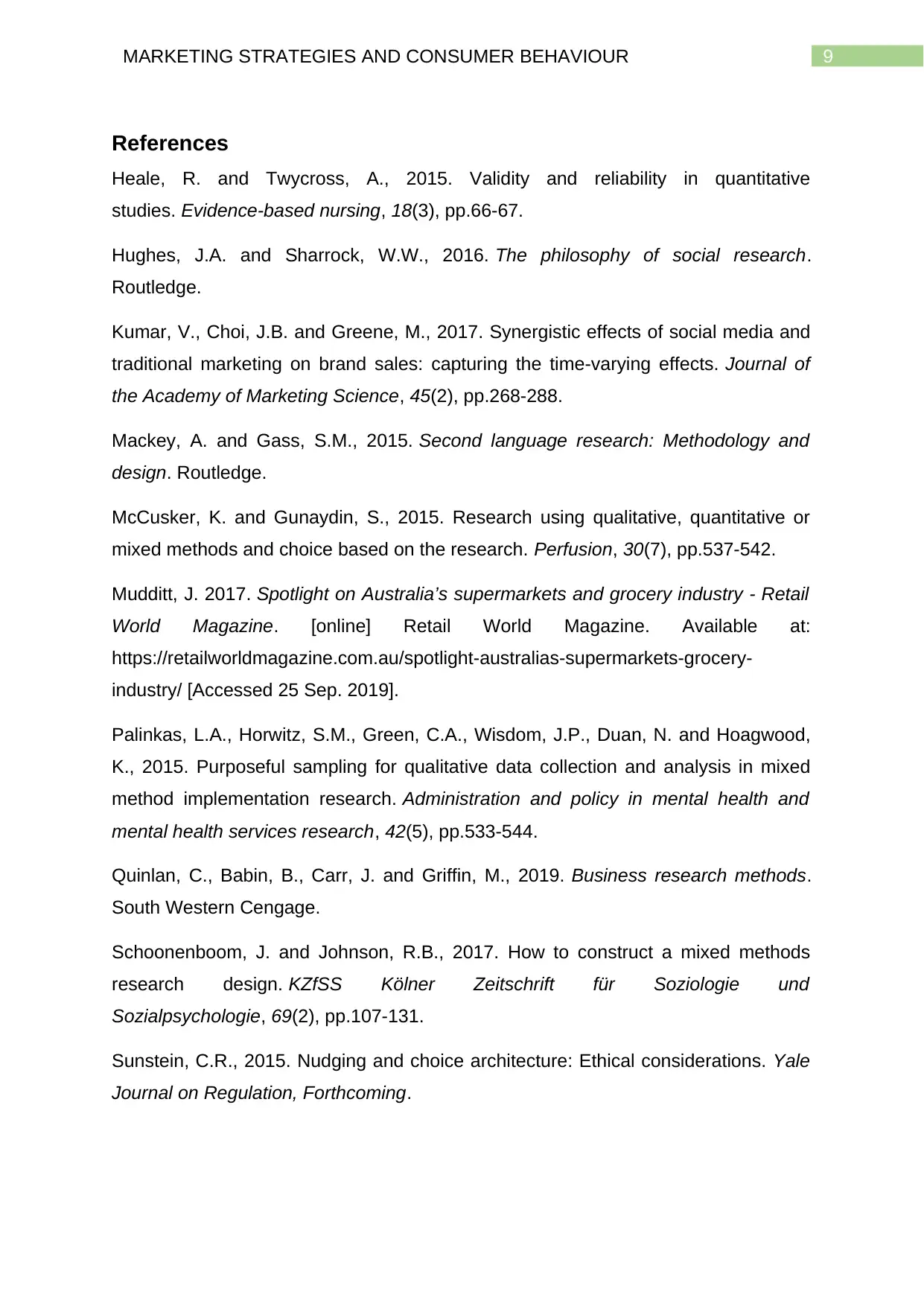
9MARKETING STRATEGIES AND CONSUMER BEHAVIOUR
References
Heale, R. and Twycross, A., 2015. Validity and reliability in quantitative
studies. Evidence-based nursing, 18(3), pp.66-67.
Hughes, J.A. and Sharrock, W.W., 2016. The philosophy of social research.
Routledge.
Kumar, V., Choi, J.B. and Greene, M., 2017. Synergistic effects of social media and
traditional marketing on brand sales: capturing the time-varying effects. Journal of
the Academy of Marketing Science, 45(2), pp.268-288.
Mackey, A. and Gass, S.M., 2015. Second language research: Methodology and
design. Routledge.
McCusker, K. and Gunaydin, S., 2015. Research using qualitative, quantitative or
mixed methods and choice based on the research. Perfusion, 30(7), pp.537-542.
Mudditt, J. 2017. Spotlight on Australia’s supermarkets and grocery industry - Retail
World Magazine. [online] Retail World Magazine. Available at:
https://retailworldmagazine.com.au/spotlight-australias-supermarkets-grocery-
industry/ [Accessed 25 Sep. 2019].
Palinkas, L.A., Horwitz, S.M., Green, C.A., Wisdom, J.P., Duan, N. and Hoagwood,
K., 2015. Purposeful sampling for qualitative data collection and analysis in mixed
method implementation research. Administration and policy in mental health and
mental health services research, 42(5), pp.533-544.
Quinlan, C., Babin, B., Carr, J. and Griffin, M., 2019. Business research methods.
South Western Cengage.
Schoonenboom, J. and Johnson, R.B., 2017. How to construct a mixed methods
research design. KZfSS Kölner Zeitschrift für Soziologie und
Sozialpsychologie, 69(2), pp.107-131.
Sunstein, C.R., 2015. Nudging and choice architecture: Ethical considerations. Yale
Journal on Regulation, Forthcoming.
References
Heale, R. and Twycross, A., 2015. Validity and reliability in quantitative
studies. Evidence-based nursing, 18(3), pp.66-67.
Hughes, J.A. and Sharrock, W.W., 2016. The philosophy of social research.
Routledge.
Kumar, V., Choi, J.B. and Greene, M., 2017. Synergistic effects of social media and
traditional marketing on brand sales: capturing the time-varying effects. Journal of
the Academy of Marketing Science, 45(2), pp.268-288.
Mackey, A. and Gass, S.M., 2015. Second language research: Methodology and
design. Routledge.
McCusker, K. and Gunaydin, S., 2015. Research using qualitative, quantitative or
mixed methods and choice based on the research. Perfusion, 30(7), pp.537-542.
Mudditt, J. 2017. Spotlight on Australia’s supermarkets and grocery industry - Retail
World Magazine. [online] Retail World Magazine. Available at:
https://retailworldmagazine.com.au/spotlight-australias-supermarkets-grocery-
industry/ [Accessed 25 Sep. 2019].
Palinkas, L.A., Horwitz, S.M., Green, C.A., Wisdom, J.P., Duan, N. and Hoagwood,
K., 2015. Purposeful sampling for qualitative data collection and analysis in mixed
method implementation research. Administration and policy in mental health and
mental health services research, 42(5), pp.533-544.
Quinlan, C., Babin, B., Carr, J. and Griffin, M., 2019. Business research methods.
South Western Cengage.
Schoonenboom, J. and Johnson, R.B., 2017. How to construct a mixed methods
research design. KZfSS Kölner Zeitschrift für Soziologie und
Sozialpsychologie, 69(2), pp.107-131.
Sunstein, C.R., 2015. Nudging and choice architecture: Ethical considerations. Yale
Journal on Regulation, Forthcoming.
1 out of 10
Related Documents
Your All-in-One AI-Powered Toolkit for Academic Success.
+13062052269
info@desklib.com
Available 24*7 on WhatsApp / Email
![[object Object]](/_next/static/media/star-bottom.7253800d.svg)
Unlock your academic potential
Copyright © 2020–2025 A2Z Services. All Rights Reserved. Developed and managed by ZUCOL.




